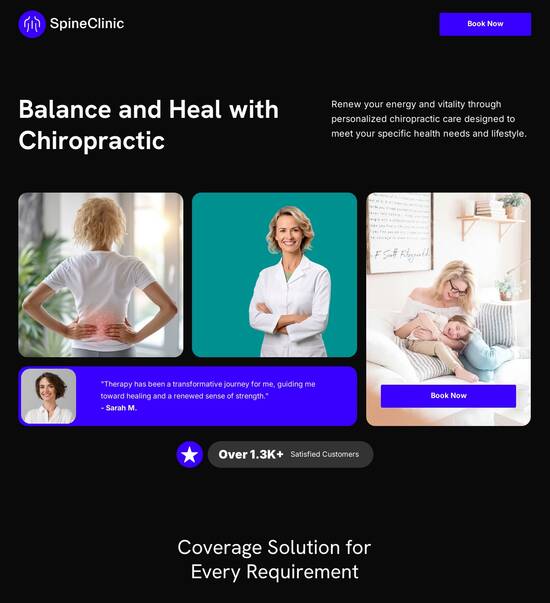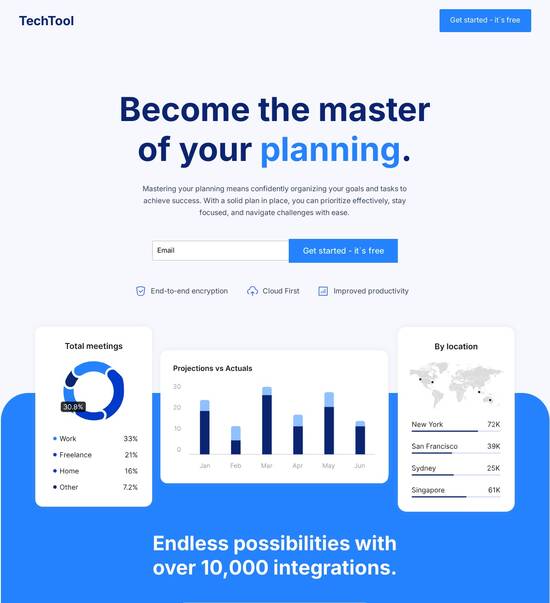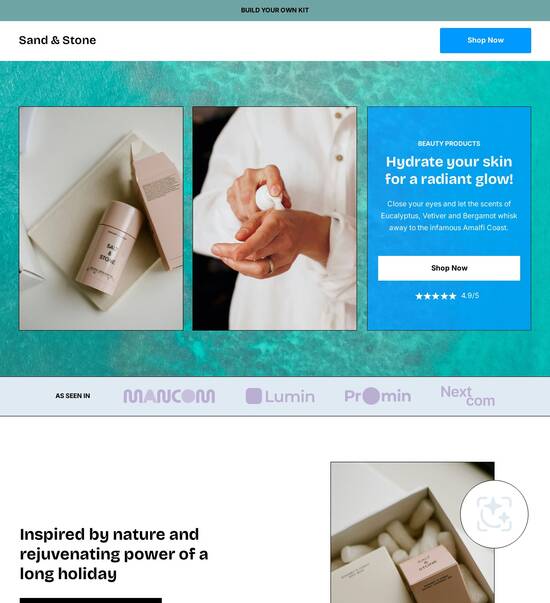
Web page template for Node.js developers
Use TemplateAbout template
Attract clients and showcase your skills with style using our landing page templates for Node.js developers. Let's convert those visitors into clients!
Recommended templates

Easy to build without coding
With the intuitive drag-and-drop builder, anyone on your team can create high-converting pages without any knowledge of code or design. Make enhancements to your landing page with custom widgets using Javascript, HTML/CSS, or third-party scripts.

Multiple layouts for any industry and goal
Select from 500+ landing page layouts built to boost conversions across industry-specific scenarios. Customize them by adjusting fonts, adding images, and generating on-brand content with the AI assistant. Quickly scale with Instablocks® and Global Blocks that you can save, reuse, and update globally.

Loads fast and looks polished on any device
Every template is responsive, which means they present professionally on any device and load blazingly fast with our Thor Render Engine. You can also power them up with Google AMP technology to deliver an unparalleled mobile experience and drive higher conversions.

Robust analytics & experimentation
Get real-time updates and reporting across all your devices, showing the number of visitors, conversions, cost-per-visitor, and cost-per-lead. Launch AI-powered experiments, run A/B tests, and use heatmaps to analyze user behavior, then optimize your landing page to maximize conversions.







Easy to build without coding
With the intuitive drag-and-drop builder, anyone on your team can create high-converting pages without any knowledge of code or design. Make enhancements to your landing page with custom widgets using Javascript, HTML/CSS, or third-party scripts.
Multiple layouts for any industry and goal
Select from 500+ landing page layouts built to boost conversions across industry-specific scenarios. Customize them by adjusting fonts, adding images, and generating on-brand content with the AI assistant. Quickly scale with Instablocks® and Global Blocks that you can save, reuse, and update globally.
Loads fast and looks polished on any device
Every template is responsive, which means they present professionally on any device and load blazingly fast with our Thor Render Engine.
Robust analytics & experimentation
Get real-time updates and reporting across all your devices, showing the number of visitors, conversions, cost-per-visitor, and cost-per-lead. Launch AI-powered experiments, run A/B tests, and use heatmaps to analyze user behavior, then optimize your landing page to maximize conversions.
All the features you need to build js web page sample
Explore more featuresLearn how to build js web page design
Frequently asked questions about js web page example
Leading the way in building high-performing landing pages





A step-by-step guide to mastering Instapage for marketers
Leveraging Instapage as your landing page and conversion rate optimization (CRO) platform can significantly transform your digital marketing campaigns. With its user-friendly interface and powerful features, you can easily create and optimize landing pages that drive higher conversions. This guide will walk you through how to efficiently use Instapage to maximize your marketing ROI.
Understanding the powerful features of Instapage
Instapage offers a plethora of features designed specifically to cater to marketing professionals across various industries. From high-converting templates to analytics tools, each aspect is crafted to simplify and enhance your landing page development process. Here’s a breakdown of what you can expect:
- 100+ ready-to-use templates: Choose from a library of high-converting templates tailored for different marketing goals.
- Dynamic text replacement: Customize your landing pages to match the keywords in your ads, ensuring a seamless user experience.
- A/B testing capabilities: Experiment with different elements on your landing pages to determine what drives the best results.
- Real-time collaboration tools: Facilitate instant feedback from team members and stakeholders, streamlining the review process.
Step 1: Choosing the right template
Selecting a template that aligns with your goals is crucial for effective campaign execution. Instapage provides customizable templates tailored to various industries, making the process straightforward. Consider the following when choosing a template:
- Audience alignment: Ensure your template resonates with your target audience's expectations.
- Goal clarity: Select a layout that complements your campaign objectives, whether it's lead generation or brand awareness.
- Mobile optimization: Choose responsive designs that look great on both desktop and mobile devices.
Step 2: Customize your landing page content
Once you’ve selected your template, it’s time to tailor the content. Make sure you personalize it according to the metrics you've collected from your campaigns. Here’s how to optimize your content:
- Use engaging headlines: Capture attention with clear and compelling headlines that reflect your offerings.
- Incorporate CTAs: Place strategic calls-to-action throughout your page to guide users towards desired actions.
- Leverage visuals: High-quality images and videos can enhance message delivery and engagement.
Step 3: Optimize and analyze for continuous improvement
With your content laid out, focus on optimization. Instapage offers built-in analytics to track your page's performance, so use this data to refine your strategy. Key metrics to monitor include:
- Conversion rates: Measure the effectiveness of your landing pages in capturing leads.
- Heatmaps: Analyze user behavior to identify areas of engagement or friction.
- A/B test results: Use insights from A/B tests to understand what resonates best with your audience.
By following these steps, you can successfully harness the power of Instapage to enhance your marketing strategies. Whether you're new to digital marketing or looking to refine your skills, this platform has the capabilities to propel your campaigns.
Start maximizing your marketing ROI today. Sign up for Instapage to elevate your digital campaigns from standard to exceptional!
People also ask about Web page template for Node.js developers
Web page templates for Node.js developers
Understanding the role of web page templates for Node.js developers
Web page templates are instrumental for Node.js developers as they streamline the process of creating dynamic, interactive web applications. By utilizing templates, developers can ensure efficient coding practices while enhancing user experience across platforms. This article explores various aspects of web page templates specifically designed for Node.js development, providing insights into their importance, essential features, and practical application in modern web development.
The evolution of web development: why Node.js matters
The rise of Node.js as a backend technology has marked a significant evolution in web development. Node.js leverages JavaScript on the server side, allowing for seamless communication between client and server. The ability to conduct real-time updates through WebSockets and its single-threaded non-blocking I/O model demonstrates its efficiency, enabling developers to handle multiple connections simultaneously.
With features like npm (Node Package Manager), developers can easily incorporate thousands of libraries and tools, simplifying the development process significantly. Compared to traditional server-side technologies, such as PHP or Ruby on Rails, Node.js offers enhanced performance, particularly in applications requiring high throughput. This comparative advantage solidifies Node.js's status as a leading backend technology in web development.
What is a web page template?
A web page template is essentially a pre-designed layout that can be reused to create multiple web pages with a consistent design and structure. Templates serve multiple purposes, such as improving development speed and ensuring design uniformity. They assist developers in maintaining best practices while focusing on core functionality.
The advantages of using templates extend beyond scalability; they also promote productivity by allowing developers to work more efficiently. Responsive design is another crucial aspect of modern templates; with users accessing websites on various devices, templates must be adaptable. A good template adjusts seamlessly to different screen sizes, ensuring a consistent user experience.
Essential features of Node.js web page templates
Node.js web page templates should embody several essential features to enhance their functional capabilities.
Modularity and reusability: Adopting modular design principles allows developers to create templates that enhance code reuse. This promotes better organization and easier maintenance.
Dynamic rendering: Server-side rendering plays a pivotal role in optimizing the performance of web applications built with Node.js. It allows for faster page loads and reduces the initial load time.
Customizable themes: Templates must support customizable themes to align with brand identity. Integrating CSS frameworks helps in maintaining consistency across pages.
Functional components: Reusable components can be integrated effectively, enabling designers to capture repetitive UI patterns and functionality.
Building a website with Node.js: a masterclass approach
Setting up a Node.js web project requires a structured approach. First, start by initializing the project with npm using the `npm init` command, where you create the package.json file that keeps track of your project dependencies. Next, choose an appropriate framework, such as Express, which is widely used for building web applications. Then proceed to establish a folder structure that includes directories for routes, views, and public assets.
When it comes to templates, leveraging popular template engines such as EJS or Pug enhances your project's efficiency. These engines allow you to embed JavaScript logic into your HTML structures, which can be particularly valuable. It’s also important to follow best practices during the development lifecycle, ensuring that your code remains maintainable and scalable. Also, performance optimizations, like minimizing your template files and managing their rendering effectively, can significantly improve user experience.
The impact of URL structure on template design
Creating SEO-friendly URLs is paramount in web design and can significantly influence template design. A well-structured URL path not only aids in user navigation but also benefits search engine optimization (SEO) efforts. The template should define URL formats that are logical and descriptive, making it easier for both users and search engines to understand the content.
Moreover, template designs influence how URL routing is implemented in a Node.js application. For example, if you're using Express, you can set up routing rules in your templates that correlate with your application’s structure. Practical examples include setting up routes that reflect the hierarchy of content within your application, helping enhance both usability and SEO performance.
Showcasing your work: the power of demos
Demos play a crucial role in the presentation of templates. They serve as a functional preview allowing potential users to experience the template before making a decision. An effective demo should include key elements such as user interactions, responsiveness across devices, and detailed showcases of functionalities offered by the template.
Case studies of successful demos often highlight their impact on user acquisition and engagement. Demonstrating real-life applications of templates allows users to relate to the problem that the template solves, ultimately making it more enticing for them to integrate such templates into their projects.
Achieving design triumph: aligning templates with entrepreneurial goals
Understanding the target market for web page templates is key for developers aiming to align their work with entrepreneurial goals. Tailored templates cater to specific industries or niches, ensuring that they meet the unique needs of businesses. By considering user experience (UX) design principles, developers can create templates that enhance engagement and ultimately contribute to higher conversion rates.
Incorporating features such as personalized content and strategic call-to-actions within templates provides a tailored experience for users. This alignment significantly boosts the chances of achieving business objectives, thereby showcasing the versatility and importance of well-crafted web page templates.
The role of a website builder in template creation
Website builders differ from hand-coded templates in several ways. Typically, website builders offer user-friendly interfaces that enable developers to create web pages without extensive coding knowledge. This can be especially advantageous for businesses looking to build landing pages quickly without a significant investment in development resources.
Node.js can facilitate a website builder experience by providing a robust backend that handles data effectively. By integrating tools and libraries like React or Vue.js, developers can create engaging user interfaces while managing complexity through a structured application architecture.
The designer's palette: customizing Node.js templates
Customizing Node.js templates requires a solid grasp of styling techniques and best practices. Advanced styling solutions include the use of CSS preprocessors like SASS or LESS, which allow developers to write more maintainable and reusable stylesheets. These tools enhance the design process by enabling variables and functions that eliminate code repetition.
Additionally, incorporating interactive elements using JavaScript frameworks can further enhance user engagement. Real-world applications often leverage third-party APIs to dynamically load content, adding a layer of functionality that makes templates not only visually appealing but also rich in content.
Real-world success stories: companies transforming their web presence
Numerous entrepreneurs have effectively utilized Node.js templates to revamp their web presence and improve overall performance. For example, companies in various sectors have reported significant increases in conversion rates after transitioning to templates that are optimized for speed and user experience.
Profiles of these success stories often emphasize the lessons learned during the redesign process. Key takeaways typically include focusing on user-centered design and periodically testing templates to identify areas for improvement over time.
Future trends in web templates for Node.js
As the web development landscape continues to evolve, several trends are emerging in the realm of web templates for Node.js. One prominent trend is the integration of artificial intelligence, which may revolutionize template design by anticipating user needs and automating adjustments to optimize user experience.
Moreover, the rise of headless CMS architectures allows for more flexibility in deploying templates across various platforms. Predicted trends also show a growing emphasis on performance optimization and accessibility, ensuring that templates are usable and effective for a wider audience.
The developer community: collaborating for innovation
Collaboration plays a pivotal role in enhancing the functionality of Node.js templates. The developer community, through forums and collaborative platforms, allows for sharing and discussing template features, functions, and best practices. Engagement in open-source projects enriches the available resources and often leads to innovations that benefit the whole community.
By leveraging these community resources, developers can stay ahead of the curve and continuously improve their skills. The ability to learn from peers and incorporate feedback into template designs leads to a more dynamic and adaptable approach to web development.
Navigating common challenges in template development
Developers commonly face a variety of challenges when creating web templates. Typical roadblocks include issues related to compatibility, scaling, and integration with other technologies. The dynamic nature of web standards may require developers to frequently adapt, which can be daunting.
Strategies to overcome these challenges include adopting standardized coding practices and utilizing modern development tools that facilitate better collaboration and testing. Continuous learning and adaptation are also crucial, as staying informed about new technologies allows developers to navigate the ever-changing landscape of web development more effectively.
Conclusion: envisioning your dream project with Node.js templates
In summary, incorporating web page templates into Node.js development not only enhances productivity but also ensures a scalable approach to web design. The benefits are multifold, allowing developers to create visually appealing, responsive, and user-friendly applications effectively.
As the market continues to evolve, embracing innovative templates while focusing on user experience will form the bedrock of successful web development. Node.js templates represent a valuable resource for developers working on diverse projects, enabling them to innovate and deliver exceptional web experiences.
Ready to skyrocket conversions?
Supercharge your ad campaigns with high-performing landing pages
Get started














